Think about it!
I did my first review of the original Evo review in 2009, my review of the Think Evo 2 back in June, 2014 which you can see at the end of this review.
In 2017 the Think Evo 3, (Length: 20′ 6″ (625 cm), Width: 18.5″ (47 cm) was launched. I bought my Think Evo 3 Ultimate(23lbs) in September, 2017 and paddled it sparingly due to paddling other surfskis for reviews. However, over the last couple of months I have put in many miles on my Evo 3 Ultimate. I have even time trialed it compared to my Nelo 550L (SCS layup) and my Stellar SEI (2G) Excel. I also did a long paddle with Chris(Nelo 550) doing intervals which confirmed my short time trials below. See the post below.
Evo 3 vs Nelo 550 vs SEI Time Trial

Back to Back Time trials of Evo 3, SEI 2G, 550L in Fall of 2017
Nelo 550, Think Evo 3, Stellar SEI Time Trials from Wesley Echols on Vimeo.
For as long as I have been paddling surfskis, I have pretty much had an Evo, Evo 2, Evo 3 in my garage, sometimes even two at a time. I even bought a used Evo for 600.00 and had it refurbished and repainted years ago. Currently my Evo 3 Ultimate sits beside my other Think skis including my Evo 2 Ultimate, Ion 3G Elite, Uno 2G Elite and hopefully an Ion 3G Ultimate in a few months. Why is the Evo been one of my favorites skis over the years? In one word: Fit.
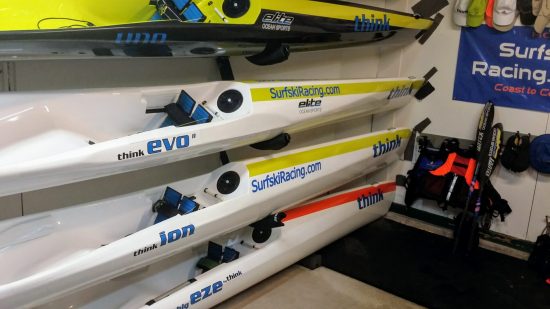
2014, my Think skis: Uno Max, Evo 2, Ion 2G, Big Eze
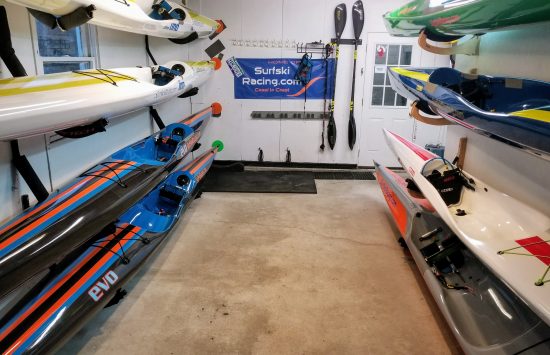
March 2018, Uno 2g, Ion 3G, Evo 3, Evo 2. Right side SEI 2G, Nelo 550L, Nelo 560M, SR. Not pictured: Basement V12 2G, SEL 2G, Stellar Double(rack outside)
Fit
For years the surfski paddler was consumed with speed first, then stability and the fit was rarely mentioned. Most paddlers thought if they squeezed into the bucket it must be a good fit. Not so fast! Then they found out, like a tight pair of pants, they are okay for walking around (flat water paddling) but sitting for hours at a desk or in a car is a another matter entirely (ocean paddling). But to the average paddler how would they know what a good fitting ski felt like. Thankfully, over the years, most brands have figured this out. Now, just about every shape and size paddler can find a surfski that fits them with rare exceptions. Paddlers like me, can fit in every ski on the market which is why I have been able to review so many skis since 2003. The 2007 Evo Generation one fit me from day one with just a little padding for a perfect fit. Then the Evo 2 came with a narrower bucket so I needed absolutely no padding which has been a rare feat for me. Remember I have no problem padding out a ski but is nice when none is required. The Think Evo 3 is an improvement with a lower hump.
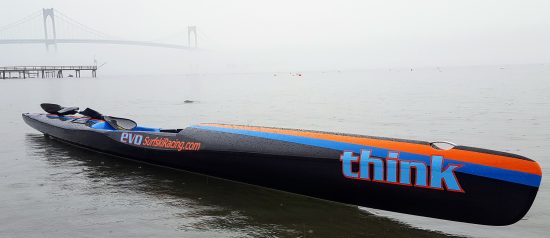
Evo 3 Ultimate with Newport Bridge in background
One of the reasons I so like my Evo’s and Ion is the personal fit of the buckets. First of all, the Think buckets have very rounded buckets. Secondly, is the fact the front of the bucket is raised slightly under the thighs to support them unlike any other surfski. Think of the front portion of your seat in your car after you press the button to raise it slightly under your thighs for a more comfortable and supportive fit. The Evo/Ion bucket has done this customization for you. Another benefit of the Evo/Ion bucket is the sitting position naturally, makes you sit up straight or leans your torso slightly forward at the waist for a great paddling position. Thirdly, in my Evo 2/3, Ion 3G, Uno 2G, the bucket depth is an appropriate, not too deep or shallow, yet very supportive. Some surfskis can be too deep making remounting difficult or you get the feeling of paddling uphill, or if too shallow, making you feel like you are on top of the ski leading to instability. With so many choices the sitting position is personal, however, for me the Evo from day one, back in 2007 his been my preference and has only improved with every generation. Other skis like the Nelo’s and Epic’s achieve ergonomic buckets too, but are designed differently with the same goal in mind.
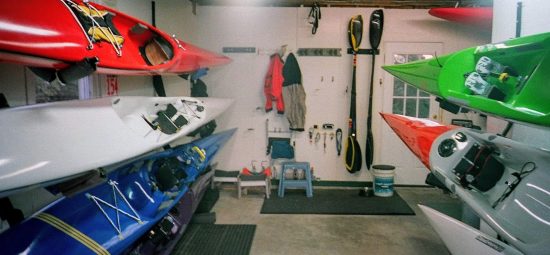
2008, 1st of 3 Mohicans, Mako 6, Fenn XT, Right side: Huki S1R, My original 2007 Evo, Kayak Pro Jet bottom.
Since the paddling stroke starts with the sitting position and ends at the footplate, I found my leg drive on my Evo ‘s is maximized compared to my other skis. The Think skis flare out slightly at the calf area(Evo 3 more) to provide another contact point for stability and to keep your legs properly lined up. I have found the size of the Think footplates and pedals to be perfect for my size 9.5 feet so most of my foot is on the foot plate and not the pedals to prevent over steer. The angle of the foot plate suits me fine as well, not too relaxed and not too straight up and and down. Also the tension on the foot pedals is excellent providing you with more direct feedback. The barrel adjuster has always been part of the toe angle adjustment with the Think skis which is simple, easy, and efficient. Another feature of the Think skis is the micro track to adjust your leg length so you can really customize this fit. So as you can see, all these features of the cockpit/footwell/footplate design led to an extremely comfortable and efficient ergonomic paddling position.
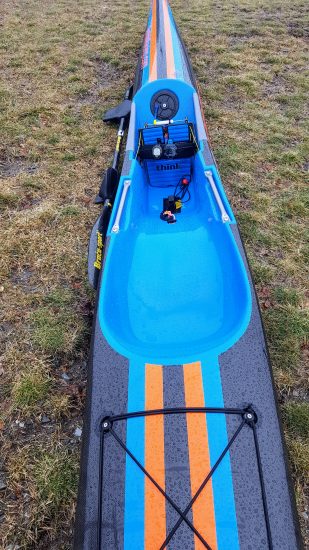
Think Evo 3 Bucket
Stability
Since the original Evo hit the market, the Evo had a twitch that many novice and intermediate paddlers were turned off by. It is immediately felt and never quite goes away unless you paddle it often. I quickly adjusted to this unique movement of the Evo. Every ski has a different feel as you know. For some paddlers they can adjust to the uniqueness of any individual ski but for others they need to keep searching. As I have said often in my other reviews(I listed all the variables), many paddler characteristics come into play when talking about stability as does proper fit, rudder size, and each individual characteristics of a ski on flat water and ocean.
I have four other intermediate skis in my garage: Stellar SR 2G, Stellar SEI 2G, Nelo 550L, Evo 2 Ultimate, along with my advanced skis: V12 2G, SEL 2G, Ion 3G, Uno 2G. The SEI, Nelo 550, Evo 2, Evo 3 are advanced intermediate skis (AIS) while the SR is considerable more stable. The other skis in this class are the Epic v10 sport, Fenn Swordfish both more stable then the advanced intermediate skis but not as fast. As I have gotten older, I like the (AIS) class particular in rough water because I can relax, paddle hard, easily remount them and still be competitive in any ocean race. The Evo 3 Ultimate like all carbon skis, regardless of brand, are less stable than their slightly heavier layups like in the Think line up the Ultimate(23lbs) vs Elite (26lbs). The carbon skis are stiffer so they do not absorb the waves, and they are lighter and more buoyant contributing to a faster but less stable ski. So once I got use to the stability of the Evo’s, I found due to the fit, I could maintain my leg drive for the most part in rough conditions and ultimately would feel more stable. This leg drive in rough water can separate the race pack early and often for the better paddlers. So here is how I would rank the intermediate skis in terms of stability: Huki S1R, Stellar SR, Epic V10 Sport, Swordfish, Stellar SEI 2G, Evo 2, Evo 3, Nelo 550. As most paddlers know, it is like light years the difference between SR and Nelo 550 so don’t think because they are in the same class there is not that much difference. That is why I separate out this class to advanced intermediate class(AIS).
Responsiveness
I have found the Evo’s always to be responsive on a wave or turning around a buoy. Low volume skis been become more popular with all brands and the Evo 3 fits nicely between the low volume skis and the larger volume skis. The Evo 3 retains it design feature of its bow rarely ever burying unlike many of the other models that require a wave deflector. Not sure which is better or worse, just pointing this out. Obviously it has some bow rocker to achieve this which also helps in ability to turn on a wave and perform in downwind and rough conditions. Occasionally I wanted an 8 inch rudder vice the standard 7.5 inch it come with here in the USA.
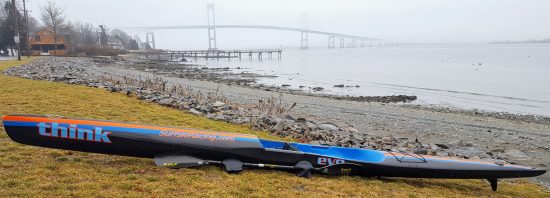
Evo 3 at our local launch site
Speed
While I had many Evo’s since 2007, I seldom raced them due to a number of factors, namely I was with Stellar from 2010-2013, then 2015-2016 where I raced my SES’s and SEL’s. Also the speed of the Evo and Evo 2 were not as fast as my SEI 1G/2G when I wanted to drop down a class. Before Stellar, I raced the advanced skis. In December of 2015, I time trialed the Evo 2 Ultimate, SR 2G, and SEI 2G in a similar manner as I did the Evo 3, SEI 2G, Nelo 550 this summer, 2017.
In this 2015, flat water time trial the SEI 2G reined supreme and the SR 2G place 2nd and Evo 2 third, by a slim margin which is what I predicted. For me, over the years, the Evo/Evo 2 shined in downwind or rough conditions. I fondly remember my faster paddles in my Evo’s. One was in my first Evo 2 Ultimate(2011) on a super flat day on the return leg from the Beavertail course(5 miles, averaging 7.8 mph) with a 5 inch rudder, one was a race in Beverly, Massachusetts years ago, and one was a training paddle(November 30, 2014) on the Sakonnet in 2/3ft seas, racing with Tim where I average 7.7 mph. Most recently, this last summer(2017) in my 2nd (current Evo 2 Ultimate) during the Paddle the Bay Race with Sean Rice, in a Northeaster, the roughest race of the year. I was tentative(tap bracing too much) having only paddled this boat once or twice before the race. See below.
Battle of The Bay 2017, Wesley Echols from Wesley Echols on Vimeo.
So when I time trialed the Evo 3 against the other AIS this summer 2017, on flat water, I was quite pleased it fared as well as the others due to the design changes. Most recently Chris(Nelo 550) and I did a 3 mile interval to Island Park, and a 1.63 mile time trial from Sandy Point to McCorrie Point. This confirmed for me the Evo 3’s speed comparatively, being even, to 2-3 boat lengths behind Chris on this day in windy conditions upwind and downwind.
Noticeable Differences between Evo 3 and Evo 2
- Hump is considerably lower in Evo 3.
- Bow volume from footwell to bow tip is much lower in Evo 3 and is not peaked. Footwell volume depth is much less in Evo 3.
- Bow Tip is different shape in Evo 3.
- Catch is considerably more narrower on Evo 3.
- Debritto Bailer in Evo 3
- Plastic Yoke(Evo 3, Ion 3G, Uno 2G) vice Metal(Evo 2)
- Seat is slightly more narrow in Evo 3 with more taper.
- Calf area contact point more pronounce in Evo 3.
- Evo 3 hull is less “V” or less peaked(flatter) starting 7ft 9inch mark from the bow and continues the flatness until 8 inches aft of the bailer. Evo 2 continues this subtle “V” 1 foot past venturi. Beginning at this point , 1ft behind drains, hulls to naked eye appear to be the same.
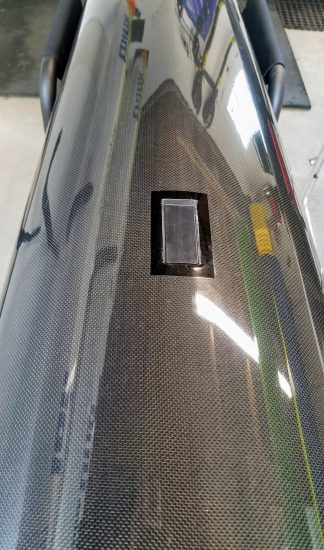
Evo 3 Hull, flatter before and after bailer.
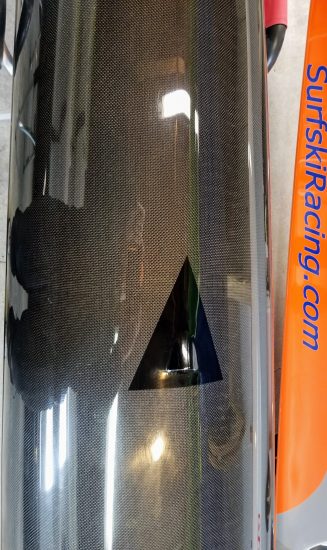
Evo 2 Hull slightly more “v” before and after drain.
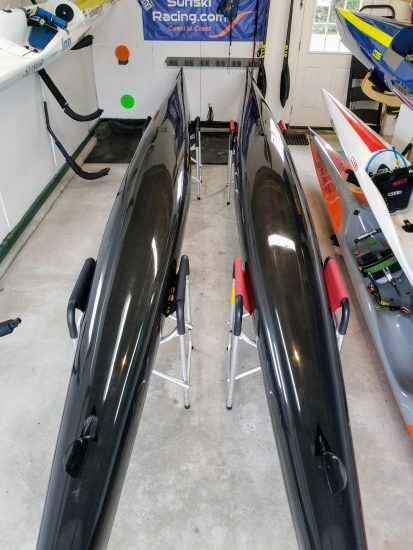
Evo 3 left, Evo 2 right, subtle hull change in the two. Hard to pick up in pictures vice the naked eye or better photos, but there and you can run your hand over both hulls to feel the changes too.
Features of Think Evo 3
- Bow and Stern Handles
- Large Bow inspection port
- Barrel Adjuster
- Micro foot track faces up vice on side of footwell.
- Foot Plate pivots
- Double foot straps(I change out to single easily)
- Spectra rudder lines
- Nice angled footplate
- Tensioned rudder lines
- Debritto Bailer(I prefer venturis on all my brand skis, less to fuss with). Remember the Mohicans were the first to use bailers in 2006. So I have been using one for a long time.
- Flared in calf as another contact point.
- Leash attachment integrated
- Choice of side handles curved or straight.
- Rear bungies
- Solid rudder yoke with set screw and pin, and tie offs.
- Nicely shaped 7.5 inch rudder
- Tiny Kelp guard(I cut off and replace my with larger one for New England weeds)
- Tethered Rudder Cap
- Custom colors available on request
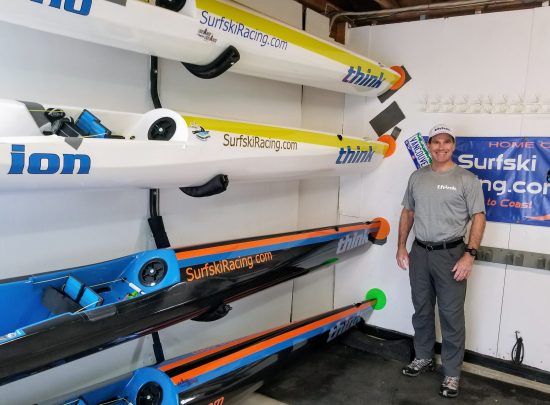
In my new Think shirt compliments of Chris Laughlin of Think Kayaks.
Think Surfski Journal, Updates
Summary
So the Evo 3 covers all the bases for me, excellent fit with superb ergonomics, upgraded sleeker design, faster in the flats and ocean, and the Evo’s have always performed well going downwind and for me in the rough stuff. It remains one of my favorite skis of all time.
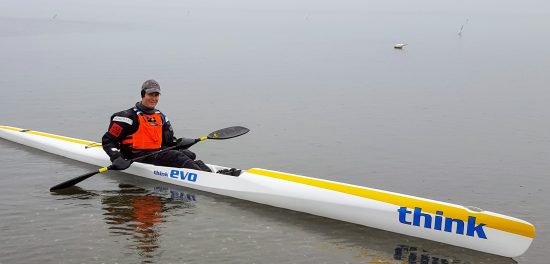
Tim Hacket, paddling friend in his Evo 3 in February 2018.
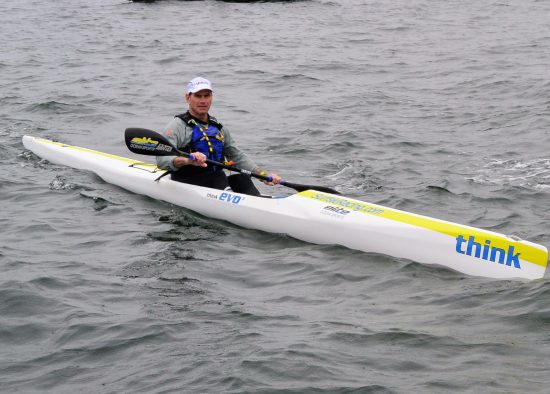
2014 Double Beaver Race in Evo 2 Elite
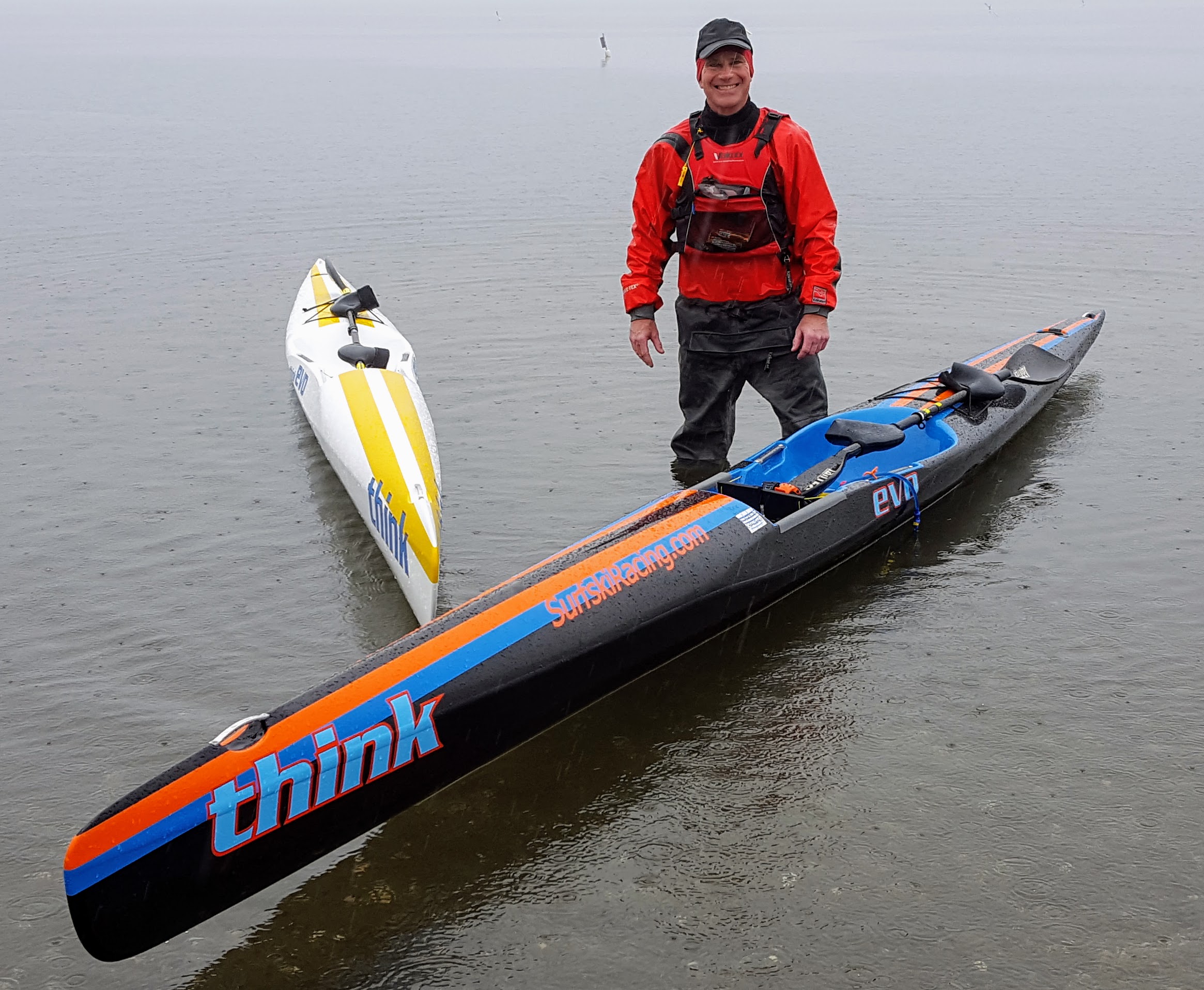
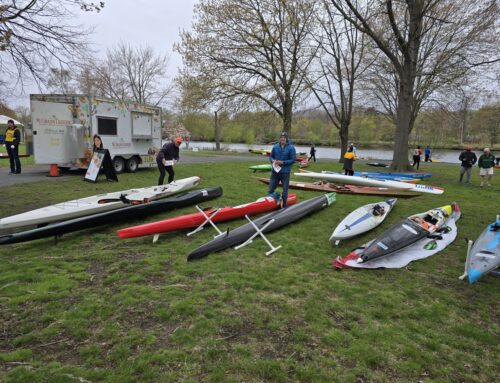
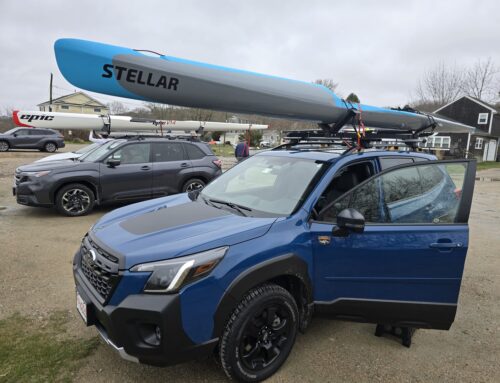
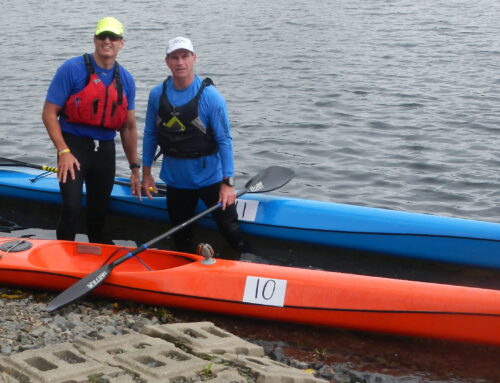
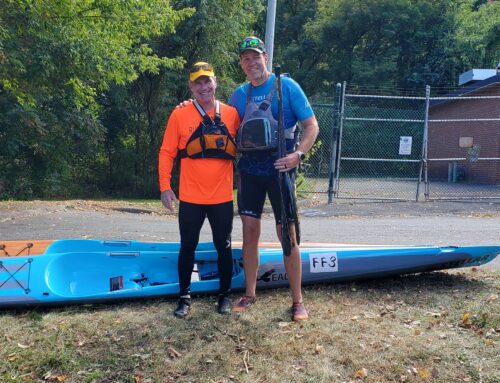
Leave A Comment
You must be logged in to post a comment.